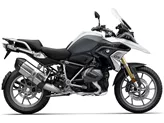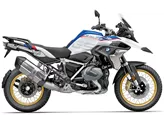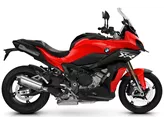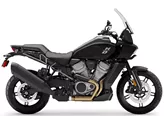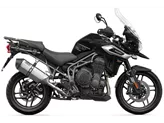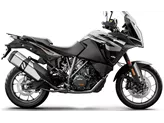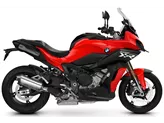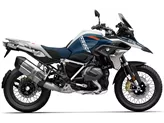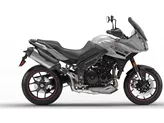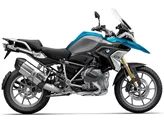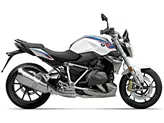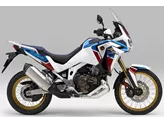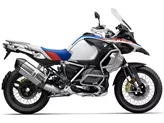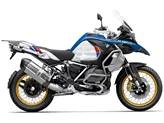Suzuki V-Strom 1000 2014 vs. BMW R 1250 GS 2019

Suzuki V-Strom 1000 2014

BMW R 1250 GS 2019
Vue d’ensemble - Suzuki V-Strom 1000 2014 vs BMW R 1250 GS 2019
When comparing the Suzuki V-Strom 1000 model year 2014 and the BMW R 1250 GS model year 2019, several key differences can be observed.
In terms of engine and drive train, the Suzuki V-Strom 1000 2014 has a bore of 100 mm and a stroke of 66 mm, while the BMW R 1250 GS 2019 has a slightly larger bore of 102.5 mm and stroke of 76 mm. This results in the BMW having a more powerful engine with 136 HP compared to the Suzuki's 100 HP. The torque is also higher in the BMW at 143 Nm compared to the Suzuki's 103 Nm. Additionally, the Suzuki utilizes a chain transmission, while the BMW uses a prop shaft transmission.
In terms of suspension, the Suzuki V-Strom 1000 2014 features an upside-down telescopic fork in the front and a monoshock in the rear. On the other hand, the BMW R 1250 GS 2019 has a telelever in the front and a monoshock in the rear. Both bikes offer a comfortable suspension setup, but the BMW's telelever system provides better stability and control.

Suzuki V-Strom 1000 2014
In terms of chassis, the Suzuki V-Strom 1000 2014 has an aluminum frame with a twin-spar design, while the BMW R 1250 GS 2019 has a steel frame with a load-bearing engine design. The aluminum frame of the Suzuki offers a lightweight and rigid structure, while the steel frame of the BMW provides better durability and strength.
In terms of rider assistance systems, both bikes offer advanced features. The Suzuki V-Strom 1000 2014 comes with traction control as standard, while the BMW R 1250 GS 2019 offers ABS, anti-slipping control, riding modes, and ride by wire. The BMW's additional features provide enhanced safety and control.
In terms of dimensions and weights, both bikes have similar front tire diameters of 19 inches and rear tire diameters of 17 inches. However, the BMW R 1250 GS 2019 has a slightly wider rear tire at 170 mm compared to the Suzuki's 150 mm. The wheelbase is also slightly shorter in the BMW at 1525 mm compared to the Suzuki's 1555 mm. The BMW is heavier with a kerb weight of 249 kg compared to the Suzuki's 228 kg. Both bikes have a fuel tank capacity of 20 liters.

BMW R 1250 GS 2019
In terms of strengths, the Suzuki V-Strom 1000 2014 offers a powerful engine, traction control as standard, very good brakes, a taut yet comfortable chassis, great touring capability, and a complete instrumentation. On the other hand, the BMW R 1250 GS 2019 boasts an extremely high-torque boxer engine, good sound, a comfortable seating position suitable for long distances, stable braking performance, good weather protection, a color TFT display as standard, and LED headlights.
In terms of weaknesses, the Suzuki V-Strom 1000 2014 has a windshield that creates turbulence on the head, an engine that runs out of breath in the upper speed range, and a confusable look. The BMW R 1250 GS 2019 has manageable standard equipment and a long surcharge list, as well as a jagged appearance with little elegance.
Overall, the BMW R 1250 GS 2019 offers a more powerful engine, advanced rider assistance systems, and a slightly more refined design compared to the Suzuki V-Strom 1000 2014. However, the Suzuki provides a solid performance, comfortable touring capabilities, and a more affordable option.
Caractéristiques techniques Suzuki V-Strom 1000 2014 par rapport à BMW R 1250 GS 2019
Avantages et inconvénients en comparaison
Avantages et inconvénients en comparaison
Suzuki V-Strom 1000 2014

Dans le segment des grosses cylindrées, la Suzuki V-Strom 1000 occupe la position de l'offre avantageuse, sans pour autant devoir renoncer à quoi que ce soit - même un contrôle de traction et l'ABS sont fournis de série. D'excellents freins, un confort exceptionnel et un moteur bicylindre en V merveilleusement puissant sont des ingrédients qui devraient plaire à presque tout le monde. Le fait qu'elle ne joue pas dans la cour des grands avec ses 100 ch est compensé par le magnifique déploiement de puissance qui assure un climat détendu lors des longs voyages. Seule la protection contre le vent n'est pas optimale avec le pare-brise d'origine, il faudrait alors investir dans un pare-brise abordable et un peu plus grand.
BMW R 1250 GS 2019

La BMW R 1250 GS est l'évolution logique de la R 1200 GS - logique surtout parce qu'on ne peut pas s'attendre à ce qu'une moto aussi populaire soit radicalement modifiée. En conséquence, le design est modifié avec précaution et les options connues sont conservées pour le châssis et l'électronique. Le nouveau nom R 1250 GS promet cependant un nouveau moteur - et il a effectivement de quoi faire ! 136 ch à 7750 tours et pas moins de 143 newtons-mètres de couple maximal à 6250 tours, c'est une véritable bombe ! BMW rénove ainsi presque parfaitement la grande GS : elle reste clairement identifiable, dispose d'un peu plus d'électronique de série, d'une liste de prix supplémentaires toujours aussi longue (que la clientèle aime cocher de A à Z) et d'un moteur encore plus performant et souverain - que peut-on demander de plus ?
Comparaison des prix Prix moyen du marché Suzuki V-Strom 1000 vs BMW R 1250 GS
There are a few key differences between a Suzuki V-Strom 1000 2014 and a BMW R 1250 GS 2019. In terms of price, the actual average price of a BMW R 1250 GS 2019 is about 128% higher. A Suzuki V-Strom 1000 2014 experiences a loss of 20 USD in one year and 290 USD in two years of ownership. This is offset by a loss of 960 USD and 910 USD for a BMW R 1250 GS 2019. Compared to BMW R 1250 GS 2019 there are less Suzuki V-Strom 1000 2014 bikes available on the 1000PS.de Marketplace, specifically 23 compared to 104. It takes less time to sell a BMW R 1250 GS with 46 days compared to 90 days for the Suzuki V-Strom 1000. Since model year 2005 1000PS.de editors have written 40 reviews for the Suzuki V-Strom 1000 and 50 reviews for the BMW R 1250 GS since model year 2019. The first review for the Suzuki V-Strom 1000 was published on 7/23/2002 and now has more than 6,300 views. This compares to more than 305,600 views for the first review on BMW R 1250 GS published on 9/19/2018.



